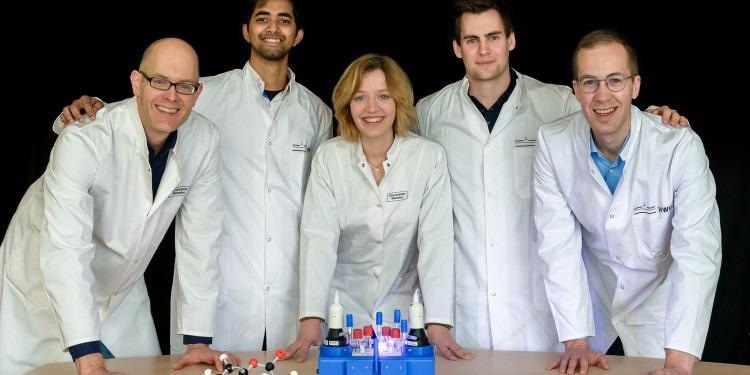As far as synthetic organic chemistry is concerned, alleged cycloadditions are known to be a specifically significant class of reactions. With the help of this kind of reaction, it is possible to construct the ring-shaped molecules simply and efficiently by linking (“adding”) two compounds each containing double bonds.
 Prof. Dr Frank Glorius (left) with Subhabrata Dutta, Tiffany O. Paulisch, Roman Kleinmans and Tobias Pinkert (from left) from the “Team Glorius”. Image Credit: © University of Münster–Peter Dziemba.
Prof. Dr Frank Glorius (left) with Subhabrata Dutta, Tiffany O. Paulisch, Roman Kleinmans and Tobias Pinkert (from left) from the “Team Glorius”. Image Credit: © University of Münster–Peter Dziemba.
A research group headed by Professor Dr. Frank Glorius from the University of Münster has currently been successful in executing an unconventional cycloaddition in which a reaction of carbon-carbon double bond takes place with a carbon-carbon single bond. In double bonds, atoms are linked by two pairs of electrons; and in single bonds, only one pair of electrons has been involved.
The significant factor to success was the usage of specifically “strained” single bonds. To allow mild reaction conditions, the chemists utilized a photosensitizer, a catalyst that forces the reaction with the help of light energy.
The study has been published in the Nature journal.
In addition to its conceptual and mechanistic importance, this method also has a synthetic benefit. This is because we can use it to build polycyclic, three-dimensional carbon scaffolds that have been difficult or impossible to access. Such three-dimensional architectures are fascinating and play an increasingly important role in medicinal chemistry.
Roman Kleinmans, Study Lead Author, University of Munster
The Chemistry in Detail
The supposed [2 + 2] photocycloadditions have been studied and developed for over a century. The study has concentrated particularly on [2π + 2π]-systems in which, for instance, two double bonds react to develop two new single bonds providing a four-membered ring product. The research group from Münster has currently obtained a discovery by identifying this kind of reaction by making use of a single bond (“2π + 2σ”).
A class of compounds along with “strained” single bonds were utilized by the researchers. They are the so-called bicyclo[1.1.0]butanes (BCBs). Such carbon compounds consist of a butterfly-like shape, with two connected triangles on the single bond that appear to be in the shape of wings.
The internal wing angles (60°each) deviate significantly from the perfect unstrained angles (109°each). The opening of the central single bond liberates strain energy — thermodynamically supporting the reaction with the carbon-carbon double bond.
With the help of this strategy, the scientists were also successful in integrating a nitrogen atom into the product’s carbon skeleton.
The visible light-driven “triplet-triplet energy transfer catalysis” enables the reaction to be performed in a very gentle manner, so irradiation of the reaction with tough UV light, which is generally utilized in the chemistry of this kind, was not required.
In this mechanism, the catalyst consumes energy from the irradiated light and sends it to an ideal substrate. The catalyst gets back to the ground state (it is regenerated), and the equivalent molecule is held in an energetically excited state, known as the (triplet state). Further, the excited molecule is able to react with the single bond.
We used a simple organic photosensitizer for this, namely thioxanthone, dispensing with rare and expensive transition metal-based catalysts.
Frank Glorius, University of Münster
To additionally comprehend the molecular mechanism of the reaction elaborately, the chemists performed computational calculations with the help of “density functional theory”.
The study was financially supported by the Chemical Industry Fund, the German Research Foundation, and the Korean Institute for Basic Science.
Journal Reference:
Kleinmans, R., et al. (2022) Intermolecular [2π + 2σ]-photocycloaddition enabled by triplet energy transfer. Nature. doi.org/10.1038/s41586-022-04636-x.